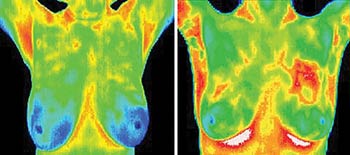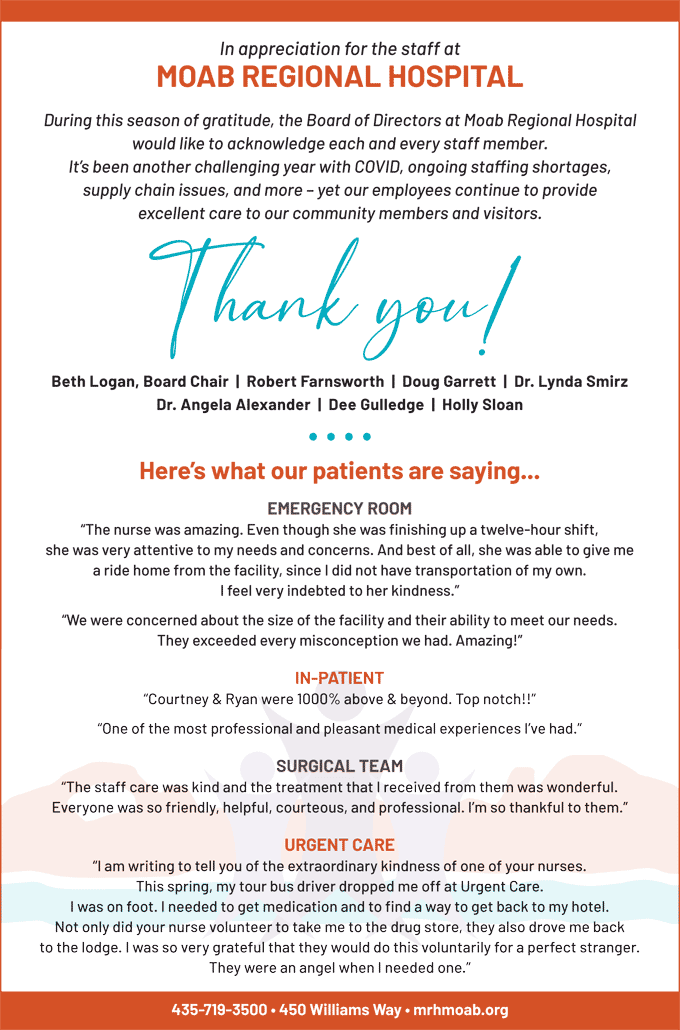As a woman, you can never afford to take your breasts for granted. It is widely known that screening for early detection is important. Unfortunately, no single method—mammography, ultrasound, MRI, self-exam, physician exam, or even thermography—will detect every tumor. Each technology and screening method has limitations and will often miss growing tumors until they are relatively large. This is why we encourage a mix of tools in order to give yourself the best odds of catching a tumor as early as possible.
 |
| Thermography draws attention to abnormalities in breasts that suggest the need for early intervention |
Whereas the government and medical industry recommend yearly mammograms, increasing numbers of women have concern about the recurring radiation and the risk of missing tumors due to fibrocystic (aka dense) breasts, which are quite widespread. Others have had painful experiences with mammograms due to tender fibro cysts or very small breasts being compressed between mammography plates. Still others are concerned about rupturing or deforming breast implants. Finally, women whose mammograms are inconclusive or suspicious often tire of returning every six months for additional films, which is not only inconvenient but also quite anxiety-provoking.
Owing to these and other concerns, we have encountered many women foregoing screening altogether because they are given only one option. This is truly heartbreaking. Due to a variety of factors, the incidence of breast cancer has increased dramatically over the last several decades. To avoid all screening is pretty close to rolling a die and hoping it doesn’t land with one dot facing up.
For these reasons, in lieu of telling you that you either get a mammogram every year or risk dying, we prefer to discuss all the tools available to you. If you can only talk yourself into getting a mammogram every five years, make sure you are at least doing something else in between.
One of the options you may not have heard of is thermography. Thermography was first developed decades ago for the armed forces to detect enemy forces in the dark. Now, night goggles are essential standard equipment for our heroes in uniform. Like many technologies, thermography has also been translated into life-saving civilian applications. Thermographic cameras can detect fractions of a degree in difference between different areas of the body, including the breasts. Those differences signal healthy tissue, inflammation, and areas of inappropriately-increased metabolic activity. Over the years, scientists have discovered patterns that raise suspicion of cancer. When suspicion is raised, a diagnostic procedure involving a biopsy is warranted.
More importantly, however, thermography draws attention to abnormalities in breasts that suggest the need for early intervention. When a tumor is identified on mammogram, for example, that tumor has been in development for a number of years. The reason it didn’t show up on last year’s mammogram is that it wasn’t large enough yet. Whereas mammography is the only approved routine screening method for breast cancer, many women often want to know if they have any sign of abnormal metabolic activity that may not yet show up on a mammogram.
When concerning patterns are identified and the mammogram is negative, this presents a great opportunity to search for and address known causes of breast cancer. It is gratifying and common for women to undertake proactive steps and witness improvements in their thermographic images over time.
If you have never had a thermogram, or if it has been more than a year since you did, consider making an appointment today. To schedule in Moab, call us at (435) 259-4008. For those who live farther north, you can call (801) 885-4616 to schedule an appointment in Lehi.
Thermographic images are taken in a private, comfortable room with a highly-experienced thermographer. There is no squishing and no contact at all. Once satisfactory images are obtained, she sends them securely to a team of thermologists, scientists with decades of experience interpreting thermograms according to standardized criteria.
Once the interpretation is available, we meet with you to discuss the findings of your thermogram, additional evaluations that may be warranted, and what you can do to improve your breast health (if necessary) before your next imaging.
Whatever you choose to do, give your breasts the attention they deserve, and be sure to utilize an array of tools. This gives you your best chance of staying alive for many healthy years to come, while at the same time keeping your breasts.
To learn more about thermography, visit UtahThermography.com.
|
One of the most serious dangers brought on by advancing years is the risk of slipping and falling. Falls can result in broken bones and other severe injuries. Besides being painful, difficult trials on their own, these injuries can easily precipitate a rapid physical decline. Luckily, seniors do not have to passively accept worsening balance and loss of bodily stability and coordination. Here are five essential exercises older folks can practice to improve their ability to balance.
1. Calf stretches. This simple exercise strengthens the legs. Seniors should perform calf raises by standing and then raising themselves up on their toes as high as possible, before gradually returning to the starting position. Calf stretches can be performed 25 or more times at once.
2. Single leg balance. This exercise is performed standing behind a chair, holding on to the top of the chair. Seniors should lift up one leg and hold it in place for as long as possible. The goal is to be able to hold the pose for a full minute. With time, as strength is regained, seniors can progress to balancing without the aid of a chair.
3. Lunges. Lunges are a lower body exercise that helps seniors regain their balance following a misstep. Lunges are performed from a standing position. Seniors should step one foot forward, bending at the knee until the thigh is straight up and down. This pose should be held for up to 30 seconds. At least ten lunges per leg should be performed.
4. Standing march. This simple exercise is exactly what it sounds like. Seniors march in place for 30 seconds or more, continually raising and lowering their knees throughout. The standing march should be performed as rapidly as is comfortable.
5. Walking a line. This exercise is completed using a line of tape on the floor or any other straight line. Seniors should slowly walk heel to toe for 25 or more steps, being sure to carefully follow the line. Extending the hands out to the side will help improve balance further.
It is true that the process of aging cannot be stopped. However, age-related declines in physical ability are not nearly as inevitable as is commonly assumed. With a proactive, dedicated approach to staying active and relatively fit, it is quite possible to minimize injury risk and to retain a high quality of life deep into old age.
In 2021, 12% of Trauma 2 activations in our ER were ground level falls in elderly patients. Most common trauma activation is still motor vehicle crashes.

|